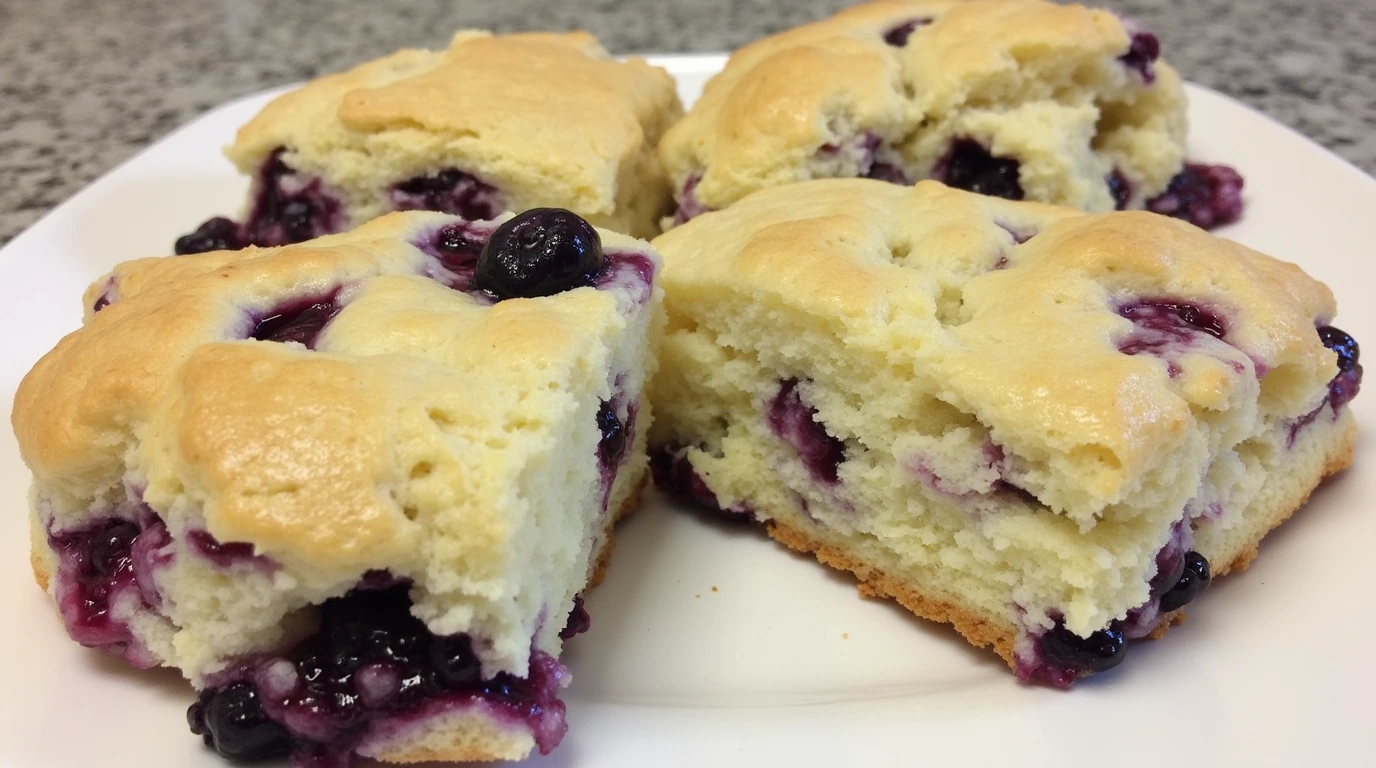Welcome to a complete guide on creating perfect buttermilk scones, bursting with juicy blueberries and a hint of zesty lemon! This scone recipe combines a few essential baking techniques inspired by the famous Tartine Bakery to deliver a treat that is flaky, tender, and rich in flavor. Whether you’re a beginner or a seasoned baker, this guide will provide tips, variations, and practical answers to common questions, ensuring you’ll bake scones that are nothing short of irresistible.
Introduction to Buttermilk Scones
Buttermilk scones are known for their tender, delicate crumb, which makes each bite melt in your mouth. The secret to this recipe’s success lies in a few key ingredients, especially cold butter and buttermilk. Cold butter, when cut into the flour, creates air pockets that expand as they bake, resulting in flaky layers. Buttermilk, meanwhile, not only contributes a mild tang but also tenderizes the dough, making it easier to handle. Adding blueberries and lemon zest further enhances the scones, bringing a bright, fruity flavor that pairs perfectly with the buttery, flaky texture.
Why Blueberries and Lemon?
Blueberries and lemon are a classic combination in baking, thanks to the balance of sweet and tart flavors. The blueberries add a natural sweetness, while the lemon zest infuses the dough with a light citrus aroma, elevating the overall taste. Not only do blueberries make the scones more delicious, but they also provide a beautiful color contrast, making your scones visually appealing as well as tasty. Blueberries are also packed with antioxidants, making these scones not just a treat but a slightly more nutritious one too.
Essential Ingredients for Buttermilk Blueberry Scones
Each ingredient in this recipe serves a specific purpose, and knowing why each is included can make you a more confident baker.
Flour
All-purpose flour provides the structure of the scones. Sift it if you can, as sifting aerates the flour, making it lighter and helping the scones to rise evenly.
Salt
Salt is crucial in baking to enhance flavor. It balances the sweetness of the scones, preventing them from tasting overly sugary and adding depth to the flavors.
Baking Powder & Baking Soda
These leavening agents give the scones their lift, creating a light, airy texture. Use fresh baking powder and baking soda to ensure the best rise.
Sugar
A small amount of sugar sweetens the scones. You can adjust the sugar to your preference; if you prefer a sweeter scone, add a tablespoon or two extra.
Lemon Zest
Lemon zest adds a hint of brightness that complements the sweetness of the blueberries. It’s a small addition, but it makes a big difference in flavor.
Cold Butter
Cold butter is essential for creating flaky layers. As it melts in the oven, it releases steam, which creates air pockets and adds flakiness to the scones.
Buttermilk
Buttermilk not only adds a slight tang but also helps to tenderize the dough. This is especially important for scones, as it creates a crumbly, tender texture.
Blueberries
Fresh or frozen blueberries add sweetness and a burst of flavor in each bite. If using frozen berries, keep them frozen until you add them to the dough to prevent excess moisture from seeping into the dough.
Key Techniques for Making Flaky Scones
Getting the right texture in scones requires some specific techniques. Here are the essentials:
1. Use Cold Butter
The colder the butter, the flakier your scones will be. Try freezing the butter for 10-15 minutes before you start baking. When you incorporate it into the flour, the butter pieces should stay intact as much as possible. These cold butter pieces will melt in the oven, creating the layers characteristic of a good scone.
2. Avoid Overmixing
Overworking the dough can make the scones tough. The key to tender scones is to mix just until the ingredients come together. If you see some dry bits or small lumps, that’s okay. Overmixing develops gluten, which is desirable in bread but not in scones.
3. Techniques for Cutting Butter
There are several methods to incorporate butter into the dry ingredients:
- Pastry Cutter: This tool is ideal for evenly cutting butter into flour without warming it.
- Food Processor: A food processor works quickly but requires a light hand to avoid over-mixing.
- Box Grater: Grate frozen butter directly into the flour, ensuring evenly distributed, small butter pieces.
Step-by-Step Instructions for Making Buttermilk Blueberry Scones
Step 1: Preheat the Oven
Preheat your oven to 400°F (200°C). Line a baking sheet with parchment paper to prevent sticking and ensure even baking.
Step 2: Mix the Dry Ingredients
In a large mixing bowl, whisk together the all-purpose flour, baking powder, baking soda, salt, sugar, and lemon zest. This step ensures the ingredients are well combined and aerated.
Step 3: Cut in the Butter
Using a pastry cutter, box grater, or your preferred method, cut the cold butter into the dry ingredients. The mixture should resemble coarse crumbs with pea-sized chunks of butter dispersed throughout.
Step 4: Add Buttermilk and Blueberries
Pour the buttermilk over the dry ingredients and add the blueberries. Gently fold the mixture using a spatula, being careful not to crush the berries. Mix just until the dough begins to come together; the dough should be slightly shaggy.
Step 5: Shape and Cut the Dough
Transfer the dough onto a lightly floured surface. Gently pat it into a 1.5-inch thick rectangle. Using a sharp knife or a biscuit cutter, cut the dough into triangles, circles, or squares as desired.
Step 6: Bake the Scones
Place the scones on the prepared baking sheet. Brush the tops with melted butter and sprinkle with sugar for extra sweetness and crunch. Bake for 20-25 minutes, or until the scones are golden brown.
Baking Tips and Variations
To make the perfect scones, here are a few extra tips and variations you can try:
For Extra Flakiness
After cutting the scones, place them in the freezer for about 10 minutes before baking. This will firm up the butter, resulting in a flakier texture.
Adding Citrus Zest
You can experiment with different citrus zests, such as orange or lime, to give the scones a unique flavor twist.
Experiment with Mix-Ins
While blueberries and lemon are a classic combination, you can also use cranberries, raspberries, or dried currants. Adding nuts like almonds or pecans can give a delightful crunch.
Serving and Storing Your Scones
Scones are best served fresh from the oven. Pair them with a dollop of clotted cream, butter, or a light spread of jam. If you have leftover scones, store them in an airtight container at room temperature for up to two days. To reheat, place them in a preheated oven at 300°F (150°C) for about 10 minutes to restore their freshness and flakiness.
Freezing Scones
If you’d like to make scones in advance, you can freeze them after shaping but before baking. Place them on a baking sheet and freeze until solid, then transfer to an airtight container. When ready to bake, pop them in the oven straight from the freezer and bake as directed, adding a few extra minutes to the baking time.
Frequently Asked Questions
1. Can I Use Frozen Blueberries?
Absolutely! Frozen blueberries are a convenient option, but they can tint the dough blue. Keep them frozen until you add them to the dough to minimize color bleeding.
2. How Do I Make Homemade Buttermilk?
If you don’t have buttermilk on hand, you can make a quick substitute. Add 1 tablespoon of vinegar or lemon juice to 1 cup of milk, let it sit for five minutes, and use as directed.
3. Can I Make Gluten-Free Scones?
Yes! Substitute a gluten-free all-purpose flour blend for the regular flour. Just ensure the blend you choose is suitable for baking.
4. How Can I Ensure My Scones Rise Properly?
Using fresh baking powder and baking soda is crucial for a good rise. Additionally, avoid flattening the dough too much; a thicker dough results in taller, fluffier scones.
5. What’s the Best Way to Serve Scones?
Scones are wonderful on their own, but they’re also delicious with spreads. Try serving with clotted cream, butter, lemon curd, or a favorite jam.
Tips for Baking Success
- Work Quickly with Cold Ingredients: Keep ingredients as cold as possible, and work quickly to avoid warming the butter.
- Use a Light Touch: Handling the dough with care helps maintain tenderness. Remember, the less you handle, the softer your scones will be.
- Avoid Over-Baking: Scones are done when the tops are golden. Overbaking can lead to dry scones, so keep an eye on them.

Buttermilk Scones with Blueberries and Lemon
Ingredients
Flour
All-purpose flour provides the structure of the scones. Sift it if you can, as sifting aerates the flour, making it lighter and helping the scones to rise evenly.
Salt
Salt is crucial in baking to enhance flavor. It balances the sweetness of the scones, preventing them from tasting overly sugary and adding depth to the flavors.
Baking Powder & Baking Soda
These leavening agents give the scones their lift, creating a light, airy texture. Use fresh baking powder and baking soda to ensure the best rise.
Sugar
A small amount of sugar sweetens the scones. You can adjust the sugar to your preference; if you prefer a sweeter scone, add a tablespoon or two extra.
Lemon Zest
Lemon zest adds a hint of brightness that complements the sweetness of the blueberries. It’s a small addition, but it makes a big difference in flavor.
Cold Butter
Cold butter is essential for creating flaky layers. As it melts in the oven, it releases steam, which creates air pockets and adds flakiness to the scones.
Buttermilk
Buttermilk not only adds a slight tang but also helps to tenderize the dough. This is especially important for scones, as it creates a crumbly, tender texture.
Blueberries
Fresh or frozen blueberries add sweetness and a burst of flavor in each bite. If using frozen berries, keep them frozen until you add them to the dough to prevent excess moisture from seeping into the dough.
Instructions
Preheat your oven to 400°F (200°C). Line a baking sheet with parchment paper to prevent sticking and ensure even baking.
In a large mixing bowl, whisk together the all-purpose flour, baking powder, baking soda, salt, sugar, and lemon zest. This step ensures the ingredients are well combined and aerated.
Using a pastry cutter, box grater, or your preferred method, cut the cold butter into the dry ingredients. The mixture should resemble coarse crumbs with pea-sized chunks of butter dispersed throughout.
Pour the buttermilk over the dry ingredients and add the blueberries. Gently fold the mixture using a spatula, being careful not to crush the berries. Mix just until the dough begins to come together; the dough should be slightly shaggy.
Transfer the dough onto a lightly floured surface. Gently pat it into a 1.5-inch thick rectangle. Using a sharp knife or a biscuit cutter, cut the dough into triangles, circles, or squares as desired.
Place the scones on the prepared baking sheet. Brush the tops with melted butter and sprinkle with sugar for extra sweetness and crunch. Bake for 20-25 minutes, or until the scones are golden brown.

